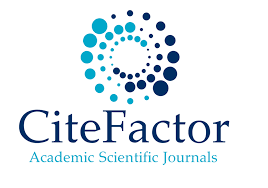ANALISIS RETURN SAHAM PERUSAHAAN PERBANKAN DI BURSA EFEK INDONESIA
DOI:
https://doi.org/10.36277/geoekonomi.v13i2.188Keywords:
EPS, BOPO, LDR, NPL, Stock returnsAbstract
The capital market has a role as a means of investing for the public to gain a return. The return expected by investors from investing can be in the form of capital gains/losses or dividends. In the 2015 - 2019 period, although in 2019 the return increased year on year (YoY), it experienced a decline in 2017 – 2018. This uncertainty in the value of stock returns is not in line with the expectations of investors who want their stock returns to continue to move up. The purpose of this study was to determine whether Earning Per Share (EPS), Operating Costs of Operating Income (BOPO), Loan to Deposit Ratio (LDR) and Non Performing Loans (NPL) can contribute to the Stock Return of Banking Sector Companies listed on the Stock Exchange. Indonesia. The sample in this study is banking companies that have been listed on the Indonesia Stock Exchange for the 2015-2019 period using quantitative data types. The data analysis technique in this study used Multiple Regression Analysis, Normality Test, Classical Assumption Test and Hypothesis Testing. The results indicate that: (1) EPS can contribute to Stock Return, (2) BOPO can contribute to Stock Return, (3) LDR can contribute to Stock Return, while (4) NPL cannot contribute to Stock Return.Â
Downloads
References
Asna, & Graha, A.N. (2006). Analisis Pengaruh Rasio Keuangan Terhadap Return Saham Perbankan Yang Terdaftar Di Bursa Efek Jakarta. Retrieved fromhttp://ejournal.unikama.ac.id/
Asri, M. H. (2017). Analisis Rasio Dengan Variabel EPS (Earning Per Share),ROA (Return On Assets), ROE (Return On Equity), BOPO (BiayaOperasional Pendapatan Operasional) Terhadap Harga Saham Perusahaan Perbankan. Retrieved from https://ejournal.gunadarma.ac.id/index.php/ekbis/article/view/1760
Ayem, S. (2017). Pengaruh Loan To Deposit Ratio, Capital Adequacy Ratio, Return On Asset Dan Non Perfoming LoanTerhadap Return Saham. Retrieved from Jurnalfe.ustjogja.ac.id
Darmadji, T.,& Fakhrudin. (2006). Pasar Modal di Indonesia Pendekatan Tanya Jawab.Jakarta: Salemba Empat.
Djajadi, L.S., & Yasa, G. W. (2018). Analisis Pengaruh Earning Per Share, Debt To Equity Ratio, Growth, dan RisikoSistematis pada Return Saham. Retrieved from https://doi.org/10.24843/EJA.2018.v23.i01.p04
Hery. (2015). Analisis Laporan Keuangan Pendekatan Rasio Keuangan. Yogyakarta: CAPS (Center for Academic Publishing Service).
Husna, N. (2016). Analisis Pengaruh Kinerja Keuangan Terhadap Harga SahamPada Perusahaan Perbankan. Retrieved from https://www.neliti.com/publications
Isnaeni, R. (2016). Pengaruh Camels Terhadap Return Saham Pada Industri Perbankan Di Bursa Efek Indonesia. Retrieved from http://repository.umy.ac.id/handle/123456789/5731
Jaworski, W.L., Zawadzka, Z. (2006). Bankowosc. Podrecznik Akademicki. Warszawa : Poltext.
Kasmir. (2008). Analisis Laporan Keuangan. Depok: PT Rajagrafindo Persada.
Kurniadi, D. (2013). Pengaruh Tingkat Kesehatan Bank Terhadap Return Saham DiBursa Efek Indonesia (BEI). Retrieved from http://publikasi.mercubuana.ac.id/index.php/Jurnal_Mix/article/view/98
Muhammad, N. K. (2015). Pengaruh CAR, NPL, dan BOPO Terhadap Profitabilitas Dan Return Saham PadaBank-Bank Yang Terdaftar Di BEI Tahun 2009-2013. Retrieved from https://media.neliti.com/media/publications/163331-ID-none.pdf
Muljono, T. P. (1999). Analisa Laporan Keuangan Untuk Perbankan,Revisi 1999. Jakarta : Djambatan.
Puspitaningtyas, Z.,& Kurniawan, A.W. (2012).Prediksi Tingkat Pengembalian Investasi Berupa Devidend Yield Berdasarkan Analisis Financial Ratio. MajalahEKONOMI: Telaah Manajemen, Akuntansi dan Bisnis, Vol. 16.
Rosita, P., Harjum, M., & Mulyo, H. (2016). Analisis Pengaruh Tingkat Kesehatan Bank Dengan Metode Camels Terhadap Return Saham (Studi Kasus Pada Bank Listed Di BEI Periode 2008-2014). Retrieved from http://eprints.undip.ac.id/48787/
Santoso, S. (2013). Statistika Ekonomi Plus Aplikasi SPSS. Ponorogo : Umpo Press.
Sugiyono. (2016). MetodePenelitian Kuantitatif, Kualitatif dan R&D. Bandung: PT Alfabet.
www.bi.go.id
www.ojk.go.id
Downloads
Published
How to Cite
Issue
Section
License
You are free to:
Share - copy and redistribute the materials in any medium or format for any purpose, even for commercial purposes.
Adapt - compose, change and develop the material for any purpose, even for commercial purposes.
The licensor cannot revoke these freedoms as long as you follow the license terms.
With the following conditions:
Attribution - you must give appropriate credit, provide a link to the license, and indicate if changes have been made. You may do so in a reasonable manner, but not in any way that suggests that the licensor endorses you or your use.
No additional restrictions - You may not implement legal provisions or technological measures that legally restrict others from doing anything permitted by the license.
Notice:
You do not have to comply with the license for elements of the material that are in the public domain or where your use is permitted by an applicable exclusion or restriction.
No warranties are given. This license may not grant all the permissions necessary for your intended use. For example, other rights such as publicity, privacy, or moral rights may limit how you use the material.







_geoekonomi.png)
_geoekonomi.png)
















